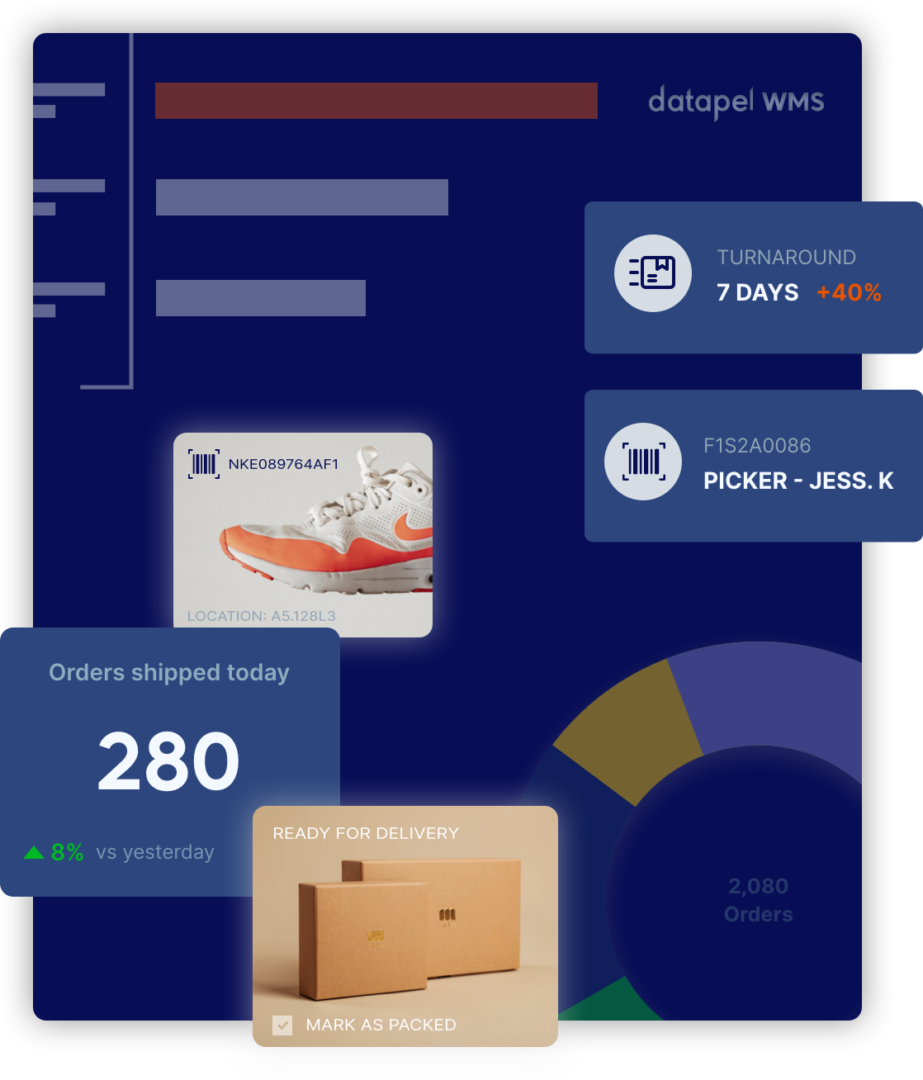Mastering Stock Replenishment: Strategies for Efficiency
Contents
When Stock Replenishment Goes Wrong, Everything Slows Down
In small to medium-sized warehouses, the most frustrating problems often start with inventory.
Running out of key products stalls fulfilment. Excess stock takes up space and cash. And yet many SMBs still rely on manual methods or guesswork to manage their replenishment.
If you’re still updating reorder sheets manually, walking the warehouse to check quantities, or ordering “just in case”, it’s time to rethink your stock replenishment strategy.
In this article, we’ll cover:
-
What makes replenishment break down in SMBs
-
The most effective replenishment strategies and when to use them
-
A real-life example of a business that fixed the problem with Datapel
-
How to choose the right strategy for your stock profile
-
Practical next steps if you want to stop stock issues for good
What Is a Stock Replenishment Strategy?
A stock replenishment strategy defines how and when you reorder inventory to maintain ideal stock levels — enough to meet demand, without overcommitting to excess.
For SMBs, it’s not about finding the perfect method. It’s about finding a repeatable, efficient system that:
-
Minimises out-of-stock risks
-
Prevents tying up capital in surplus goods
-
Responds to changing demand patterns
And it must work without adding admin overhead to already stretched operations teams.
Why Replenishment Breaks Down in Growing Businesses

Replenishment issues often start small — a missed order here, a late delivery there — and gradually snowball into a chronic issue that affects customer satisfaction and cash flow.
Common causes include:
-
Lack of real-time visibility: You’re basing decisions on static spreadsheets or outdated counts.
-
No automated alerts or triggers: Stock runs low before anyone notices, or it gets reordered too late.
-
Inconsistent rules across SKUs: Fast-moving and slow-moving stock are treated the same.
-
Disconnected systems: Sales data doesn’t sync with purchasing or warehouse stock levels.
Without a clear replenishment strategy — and the systems to support it — inventory becomes reactive rather than planned. That’s when stockouts, overstock, and fire-drill ordering cycles become the norm.
Three Proven Stock Replenishment Strategies for SMBs

Not every strategy suits every product — or business model. Below are three widely used methods SMBs can implement using modern inventory software like Datapel.
1. Reorder Point (ROP) Strategy
Best for: High-volume, consistent-demand SKUs with steady lead times.
The reorder point strategy is simple but powerful. You define a minimum quantity (the reorder point) for each SKU. When inventory drops to that point, the system alerts you — or automatically raises a purchase order.
What it solves:
-
Prevents stockouts on high-demand items
-
Ensures you always have buffer (safety stock)
-
Keeps inventory turnover efficient
How Datapel supports it:
-
Calculates reorder points based on lea
-
d time, average daily usage, and safety stock
-
Generates alerts or auto-orders when stock hits the threshold
-
Tracks actual usage and adjusts suggestions dynamically
Example:
Let’s say you sell 10 units of a product per day, and your supplier lead time is 5 days. With a safety stock of 20 units, your reorder point would be:
(10 units x 5 days) + 20 = 70 units
As soon as your stock dips to 70, Datapel triggers the order — before the shortage affects sales.
2. Lean Replenishment (Just-in-Time Approach)
Best for: Perishable goods, fast-moving consumer products, businesses with limited storage.
Lean replenishment focuses on smaller, more frequent orders based on real-time demand. Instead of bulk buys, you replenish what’s needed — when it’s needed — to keep inventory lean and cash flowing.
What it solves:
-
Reduces dead stock and holding costs
-
Frees up warehouse space
-
Improves responsiveness to demand shifts
How Datapel supports it:
-
Real-time inventory data across sales channels
-
Dynamic purchase suggestions based on live usage
-
Supplier performance tracking to ensure timing reliability
Example:
A food wholesaler receives daily sales data from its B2B customers. Rather than restocking weekly, Datapel recommends order volumes every two days based on sales velocity. This reduces expired goods and keeps stock fresh.
3. Forecast-Based Replenishment
Best for: Seasonal products, promotional inventory, trend-driven industries.
Forecasting uses historical data to predict future demand — allowing you to replenish based on expected sales, not just current levels.
What it solves:
-
Prepares you for seasonal spikes
-
Reduces missed revenue during peak periods
-
Enables longer-term planning with suppliers
How Datapel supports it:
-
Generates reports on seasonal trends, top-selling SKUs, and customer buying behaviour
-
Visual dashboards to plan months in advance
-
Integration with external sales platform
-
s to consolidate data
Example:
A giftware supplier knows sales triple in Q4. Datapel’s historical analysis suggests when to reorder holiday stock — and how much — based on the previous three years’ order data.
Strategy Comparison Table
| Strategy | Best For | Key Benefit | Datapel Capability |
|---|---|---|---|
| Reorder Point | High-volume, predictable SKUs | Prevents stockouts with safety net | Auto-alerts, PO automation |
| Lean Replenishment | Perishables, high-turnover products | Reduces storage and holding costs | Demand-based restock suggestions |
| Forecast-Based | Seasonal/promo inventory | Prepares for spikes in demand | Historical reporting and sales trends |
Real Example: How Hampers with Bite Took Back Control
Hampers with Bite, a fast-growing B2B gift hamper provider, was facing serious replenishment challenges — especially during high-demand periods like Christmas.
The problem?
-
No centralised stock visibility across locations
-
Manual order processes leading to under- or over-ordering
-
Difficulty forecasting promotional demand
The solution? With Datapel:
-
Inventory was centralised and updated in real-time
-
Replenishment alerts were set by SKU, based on sales patterns
-
Forecasting tools helped plan ahead for seasonal spikes
The result? More accurate ordering, fewer missed sales, and a faster fulfilment cycle — just in time for their busiest season.
How to Choose the Right Strategy for Your Business

There’s no one-size-fits-all solution. Many businesses use a hybrid approach — combining ROP for essentials, lean for fast-sellers, and forecasting for seasonal items.
Here’s how to decide:
-
Start with your top 20% of SKUs by sales — which strategy would protect these the most?
-
Map supplier lead times — longer lead times = higher risk of stockouts = better suited to ROP or forecasting
-
Review shelf life and storage limits — this often makes lean replenishment more attractive
The key is having systems in place to apply different strategies without increasing your workload. That’s where Datapel helps — by embedding replenishment logic directly into your purchasing workflows.
Avoid These Common Replenishment Mistakes
-
Treating all products the same: Replenishmen
-
t should reflect item value, turnover rate, and risk.
-
Relying solely on manual reviews: Weekly stocktakes don’t match the pace of modern sales cycles.
-
Operating with disconnected systems: Sales, inventory, and purchasing must work from the same data to be accurate.
-
Ignoring supplier reliability: If your lead times vary, so should your replenishment buffer.
Get the Right Replenishment Strategy — Without Guesswork
Stock replenishment doesn’t need to be a guessing game.
With Datapel, you can:
-
Set intelligent reorder points
-
Automate lean restocking
-
Use data to forecast demand accurately
-
Unify your sales and warehouse data for real-time decisions
Ready to take the pressure off your purchasing team — and improve fulfilment speed?
Book a personalised demo and see how Datapel can support your stock replenishment strategy.
You Might Also Like:
Frequently Asked Questions
What is replenishment?
Replenishing means to refill or restore something to its original state. It’s replenishing what’s been used up to make it whole again and back to its former state.
What’s another word for replenishment?
Recharging, refreshing and replacing are often used to mean the same thing: replenishment.
Example of replenishment?
Replenishment planning involves moving inventory from reserve storage to warehouse picking shelves where it can be picked for order fulfilment. It can be any of the following: shipping raw materials from suppliers to manufacturing facilities, ordering inventory from suppliers to have enough product, or reviewing inventory levels at certain points in time to reorder.
What does need replenishment mean?
Replenishment means replacing what’s been used, so we have something to use again. We need to refill or restore items to a usable state.
What does replenishing our stock mean?
Restocking our inventory helps maintain the required balance of items on store shelves by replenishing any products that have sold out during a given period. This means ordering and adding new inventory to replace what has been depleted from sales.

As a WMS Industry Analyst & Content Lead I write about warehouse management systems from real experience—helping businesses streamline operations, reduce errors, and scale smarter.
Over the past 8 years, I’ve worked closely with warehouse teams, tech developers, and business owners to break down complex supply chain problems into actionable solutions. My goal? Make WMS content useful, not just informative.
When I’m not writing, I’m digging into user feedback, testing new tools, or speaking with industry experts to stay ahead of what matters most to warehouse operators.








